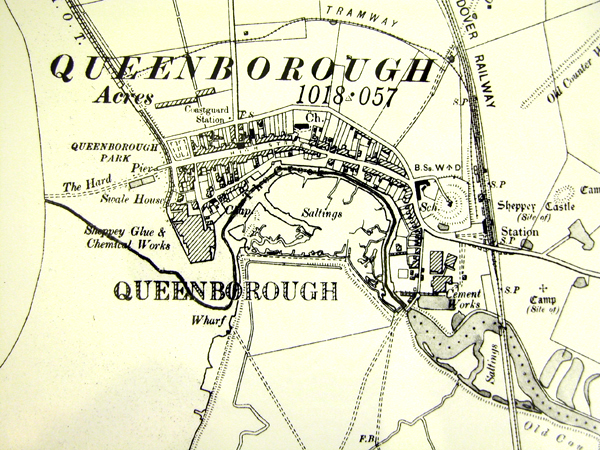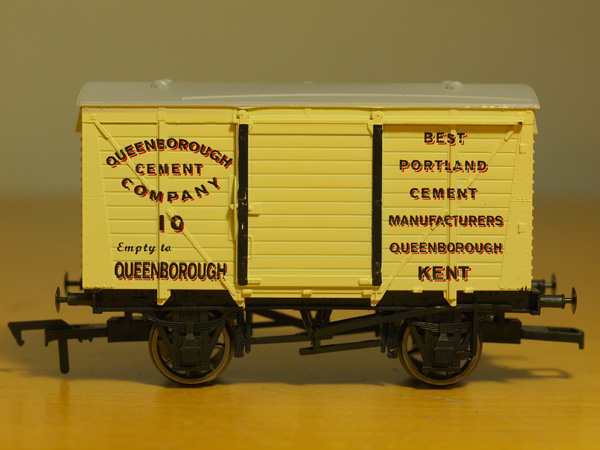The Queenborough Cement Company was situated near Queenborough Station, as shown on the map below:

Ownership/history:
1860s
Started in the early 1860s by Alfred Castle as Castle’s Queenborough Cement Works. The works were sited at the head of Queenborough Creek, making them accessible by road, river, and later rail.
1882 – 1897 Josiah Hall and Co.
By 1880 the works were known as Queenborough Cement Works and consisted of a cooper’s shop, small bagging shed, together with four beehive kilns, sometimes producing 400 tons a week, and a grinding mill.
1897 – 1911: Queenborough Cement Company Limited*.
Directors: Captain E. W. Jaffray (Edward Woodriff), J. E. (James Edward) Castle.
In 1897, Chalk Wharf was built for the cement company.
Barges registered to J. E. Castle:
| Name | Date | Built at | Rig/Reg tons | Official Number |
| Alice | 1875 | Millwall | Spritsail 42t | 67111 |
| Alice | 1883 | Rochester | Spritsail 41t | 87210 |
| Atalanta | 1865 | Queenborough | Spritsail 40t | 52941 |
| Charles & Gordon | 1891 | Rochester | Spritsail 44t | 98809 |
| Dahlia | 1880 | Rochester | Spritsail 44t (42t?) | 81869 |
| Elizabeth | 1863 | Sittingbourne | 39t | 45528 |
| Emma | 1866 | Sittingbourne | 41t | 55135 |
| Hand in Hand | 1891 | Rochester | Spritsail 44t | 98798 |
| James Bills | 1872 | Milton | Spritsail 43t (42t?) | 67045 |
| Kenneth | 1878 | Wandsworth | Spritsail 43t (48t?) | 79627 |
| Peacock | 1866 | Rochester | Spritsail 43t | 55162 |
| Queen | 1848 | Rochester | Spritsail 43t | 7994 |
| Thelma | 1901 | Sittingbourne | Spritsail 50t | 113701 |
| Trent | 1878 | Frindsbury | Spritsail 42t | 104328 |
| T. F. C. | 1895 | Rochester | Spritsail 46t | 104323 |
| Willie & Lily | 1890 | Rochester | Spritsail 45t | 97726 |
The barges were used to transport the cement to London and beyond.
1911 – 1914 British Portland Cement Manufacturers Ltd.
From the 1890s there was a narrow gauge works railway.
The works were demolished during the 1914-18 war to provide hardcore for the war department, which was used for roads being constructed on the island.
The Castles also ran thousands of tons of flint and chalk to Sheppey to help build up the railway embankment for the extension of the London, Chatham and Dover Railway to Queenborough in 1860.

Reproduction model of a Queenborough Cement Co. wagon
Association with Sharp’s Green (Horrid Hill) Cement Works:
In the 1860s Alfred Castle used to moor his barges at Sharp’s Green Bay to collect chalk from Twydall chalk pit. The chalk was transported by a fleet of barges owned by Alfred and his brother James, back to their two cement works at Queenborough.
The chalk was taken to the barges on a track that led from the quarry to Sharp’s Green Bay, but the loading could only be done at low tide – so Castle built a wooden jetty further down the channel allowing loading to be undertaken at all states of tide.
To improve the speed of loading, Castle also built a narrow gauge horse-drawn railway from the quarry to the new wooden jetty, with side tipping railway carts used to allow the barges to be loaded quickly.
Links:

This info. about the Queenborough Cement Company is tantalyzing, mainly because I’m an American relative of Captain Edward Woodriff Jaffray, the Company’s one-time Director.
Captain Jaffray and his daughter, Mary Helen, resided in Queenborough for many years. He was Mayor and both father and daughter served in other capacities for the local government. Miss Jaffray was an Air Raid Warden during WWII.
Captain Jaffray died at the County Hospital on January 19, 1939, and had resided at “The Bungalow” prior to that, possibly with Mary Helen. Is there a picture, a real estate description or post card showing that home, or of the area as it looked in 1939? Was it located near the Cement Company?
In addition to being a business man, Captain Jaffray – as he was always known – may also have been a lawyer and/or an electrical engineer. He was a cavalry veteran of the 13th Hussars and may have had mining interests in Mexico in the early 1900’s.
I’d like to discover more about him and his daughter, Mary Helen. Did she lived out her life in Queenborough and, if not, where and when she did die?
I’d love to visit Queenborough in person, but need a local proxy who can tell me what’s available. For instance, is there a written history of the Air Raid service and its contributions and, did Sheppey’s location give it extra importance? Did the Jaffrays garden or fight for the under-dog, (both strong Jaffray traits on this side of the Atlantic.)
Interestingly, one of these Jaffray’s American cousins was Daisy Harriman, (Florence Jaffray Hurst Harriman), FDR’s Ambassador to Norway during WWII.
While Mary Helen was watching the skies over the Channel, Hitler’s Blitz blasted Daisy and the Norwegian government straight out of the country!
I wonder if each knew of the other’s contributions and their kinship?
If any genealogists in Queenborough can help me explore old newspapers, court records, directories, real estate transactions, etc., I’d sure love the help.